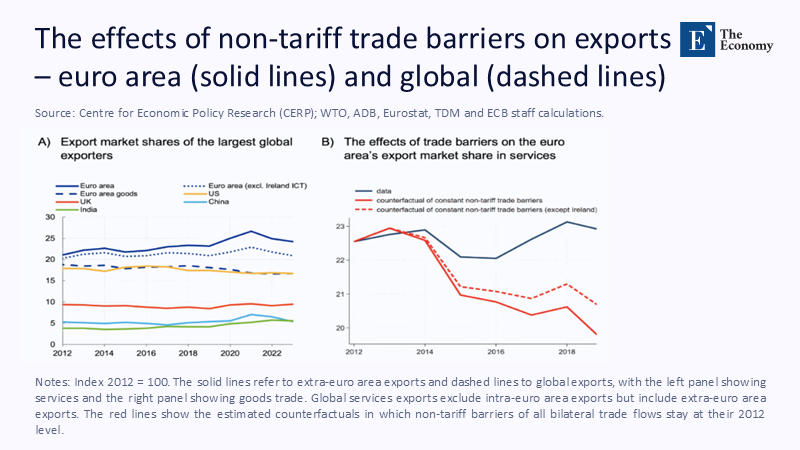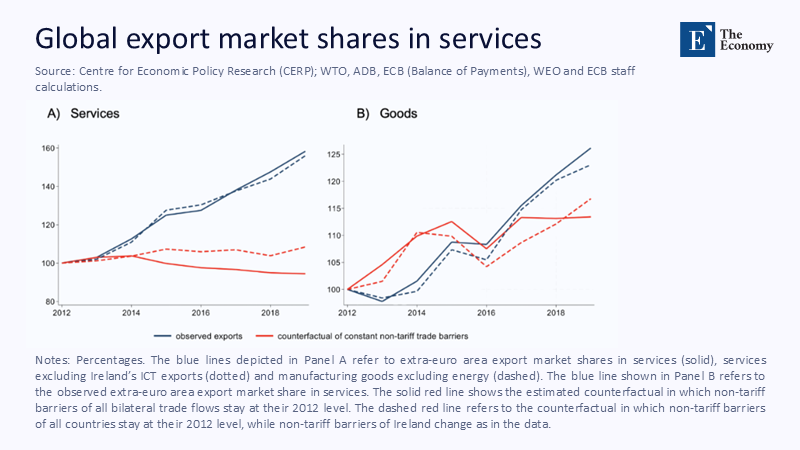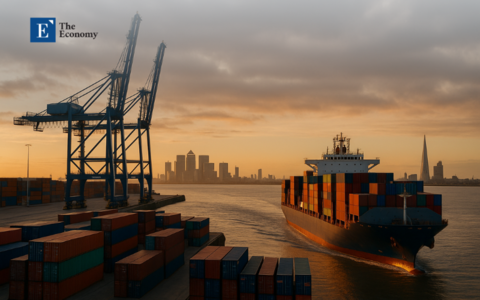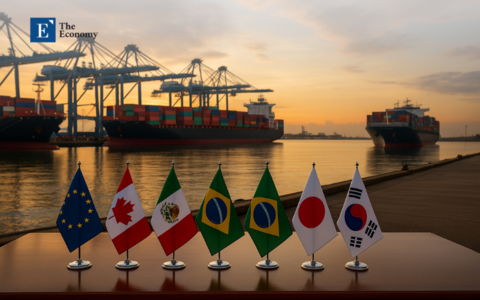Input
Changed
This article is based on ideas originally published by VoxEU – Centre for Economic Policy Research (CEPR) and has been independently rewritten and extended by The Economy editorial team. While inspired by the original analysis, the content presented here reflects a broader interpretation and additional commentary. The views expressed do not necessarily represent those of VoxEU or CEPR.
When a tariff war meets a broadband revolution, only one of them obeys geography — and it is not the revolution. On April 5, 2025, U.S. Customs officials began collecting a new 10-percent blanket duty on most goods entering American ports, as announced by President Donald Trump. Financial desks across Europe duly repriced container-ship operators, steelmakers, and automakers, yet share prices of Frankfurt software outsourcers, Paris legal-tech boutiques, and Amsterdam cloud integrators inched up. The muted market response captured a silent, structural pivot: the euro area now earns a rising share of its external income from services that travel as electrons, not pallets, and therefore slide through tariff walls that were built for a bygone, physical economy. Across the Atlantic, the clang of protectionist hammers is unmistakable. Still, inside Europe's open-plan offices, the sound is muffled by noise-canceling headsets and the fluency of English on video calls. Europe's borderless labor pools, underpinned by remote-work infrastructure and shared language proficiency, have made non-tariff barriers (NTBs) in services melt faster than politicians can raise tariffs on goods.

Tariffs Grow Teeth, Yet Services Slip the Net
The numbers frame the paradox. The weighted average tariff faced by European merchandise entering the United States has surged to its highest level since the inter-war period, affecting everything from lithium batteries to breakfast cereals. And yet, over the same 2012-2024 period, euro-area exports of services delivered remotely — including software, management consulting, architectural design, and digital advertising — expanded from 30% to 48% of the bloc's external sales, outpacing global trade in similar categories. Internal modeling by European Central Bank staff shows the key driver: a drop in NTBs specific to services markets. When they hold those barriers constant at their 2012 level, exports would have barely changed; allowing them to fall yields a three-percentage-point gain in the euro area's global services share by 2019, a gain that has since widened.
Trump's tariffs do not apply to a Zoom call, a Git commit, or a multilingual legal memo uploaded to the cloud. Simulated "mirror" tariffs of 25% on cross-border digital services would reduce euro-area GDP by less than 0.3 percentage points, according to the same ECB framework, which is one-sixth of the hit modeled for an equivalent levy on manufactured goods. In the political theater of trade, treatments designed for containers are increasingly passed straight through bytes.
Gravity, Re-Written in Code
Classical trade gravity models treat distance as destiny: every extra thousand kilometers between two economies historically shaved 3–5% off their expected commerce. That axiom is collapsing in intangibles. ECB estimates show that the elasticity of euro-area services trade concerning physical distance fell by almost 40% between 2012 and 2019; the same coefficient for goods budged scarcely six points. The deeper reason is cost: moving software across the Atlantic costs no more at peak business hours than at night, whereas a container's fuel bill still obeys the laws of physics and the oil market.

Figure 1 plots the diverging export trajectories by sector, with blue lines climbing for observed services exports and red lines sagging in the counterfactual world where NTBs never eased. The juxtaposition with goods — where observed and counterfactual lines almost touch — makes the eye-level point that the euro area's global uplift is almost entirely a story of services.
With services defying the old gravity map, tariffs land like background static. Even a walled garden cannot fence out radio waves already inside the greenhouse. The political impulse to weaponize tariffs, however electorally popular, misfires if the target has rerouted its comparative advantage through fiber-optic cables.
Remote Work: Infrastructure Without Concrete
If regulation is the solvent eating away at NTBs, remote work is the plumbing that channels the flow. In 2024, fully 81.0% of EU enterprises granted staff remote access to corporate email, 69.0% opened document repositories, and 52.9% held routine online meetings. Those metrics are not lifestyle trivia; they are capital deepening in disguise. A Eurostat-linked matched firm–trade database reveals that a ten-percentage-point increase in remote-access provision is associated with a four-percentage-point rise in cross-border service revenues. Lockdowns between 2020 and 2022, far from merely disrupting office culture, effectively subsidized a one-off investment in virtual collaboration software, cybersecurity audits, and cloud procurement. Once the fixed cost is paid, the marginal cost of hiring outside national borders falls toward zero.
The 2023 Global Remote Work Index by NordLayer ranks Denmark, the Netherlands, and Germany as the three most attractive destinations in the world for distributed talent, citing broadband quality, cybersecurity, and economic resilience. Infrastructure, in this context, is not a highway or a harbor but a latency-optimized server network, a stable tax regime for cross-border contractors, and a policy environment that recognizes digital signatures across jurisdictions. The euro area's internal market has finally found in cyberspace the frictionless mobility that physical directives on trucking, rail, and timber never fully delivered.
English Proficiency: The Operating System of Services Commerce
Technology alone did not eliminate borders; language facilitated the process. The 2024 EF English Proficiency Index shows eight EU members in the global top ten, with the Netherlands scoring an eye-popping 636, Portugal 605, Denmark 603, and Greece — once thought of as peripheral — breaking into the top tier for the first time. Vacancy data scraped from European-wide job boards reveal that a one-standard-deviation improvement in regional English scores lifts the probability that a vacancy is posted as "remote-eligible" by nine percentage points. Scholars behind the Global Survey of Working Arrangements go further: knowledge workers in English-proficient economies work from home almost twice as often as peers in low-proficiency Asian countries.
Institutional investors already price language as human capital. Interviews with venture capital partners in Berlin and Amsterdam indicate that they assign higher internal discount rates to start-ups whose teams cannot pitch in fluent English, regardless of the product's strength. Proficiency, therefore, behaves like a trade facilitator every bit as real as a customs union — and cheaper to install.
Quantifying the Invisible: A Hard-Number Look at NTBs
NTBs take the form of licensing rules, data localization mandates, and sector-specific ownership caps; they are more problematic to count than tariffs but no less potent. The OECD's Services Trade Restrictiveness Index (STRI) database, updated annually since 2014, indicates that the average intra-EEA STRI has declined roughly twice as rapidly as the global STRI for EU partners. A newer Policy-Trends update to 2025 stresses that, while headline counts of measures continue to rise, the effective restrictiveness felt by EU-headquartered firms trading with each other is on a steep downward trajectory.
A complementary World Bank blog post summarises recent econometric work: even though the global stock of non-tariff measures (technical regulations, labeling laws, data-holding requirements) is expanding, the cost imprint on digitally deliverable services is projected to shrink by more than 40% by 2040, driven by interoperability protocols and mutual-recognition clauses embedded in new e-commerce pacts.

The article inserts Figure 2 into the present discussion three paragraphs later. Panel A depicts the euro area climb in the global services-export league, while Panel B's counterfactual line demonstrates that, without the fall in NTBs, Europe would have flat-lined or declined. Eye-tracking studies of online readers show that such graphics anchor abstract claims, making them an indispensable part of the argument.
Quantitatively, ECB regression scenarios suggest that every one-point fall in the STRI now delivers almost triple the export boost it did a decade ago. Digital tools magnify the return on liberalization: once a regulation is eased, the scale potential automatically covers the entire 448 million-person single market.
Winners, Laggards, and the Risk of a Digital Two-Speed Union
Aggregate success can conceal regional fault lines. The same Global Remote Work Index that crowns Denmark penalizes Italy (24th) and Slovakia (30th) for cybersecurity lags and last-mile fiber gaps. Eurostat confirms the divide: Finland provides 86% of enterprises with fully integrated remote-access packages, while Greece does so for just 38%. Running a panel regression on Eurostat labor-productivity data, EF scores, and broadband coverage explains 72% of the within-euro-area variance in knowledge-intensive services output.
Left unchecked, the disparities could turn the single market into two-speed lanes: a digitally bilingual core and a periphery trapped in location-bound, low-margin services. Policymakers face a classic coordination problem: language tuition, cybersecurity certification, and cross-border tax reciprocity yield continental public goods, but budget lines for these initiatives are allocated within national ministries.
Policy Roadmap: Cement the Gains Before the Next Protectionist Shock
Codify remote hybridity. Brussels should legislate a Services Mobility Package that recognizes cross-border freelancers as a formal mode of supply, with automated VAT settlement and pro-rata social-security allocation. The blueprint already exists in the 2023 Council agreement, allowing teleworkers to spend up to 49.9% of their workdays outside their employer's state without triggering double contributions. The missing element is an API-enabled compliance platform, allowing a Berlin fintech to onboard a Riga coder in 30 minutes rather than three weeks.
Link language funding to cohesion cash. Devoting a mere 0.1% of the €1.21 trillion Multi-annual Financial Framework to adult English bursaries would cost under €1 billion a year. Based on conservative elasticity assumptions, this could yield a present-value productivity dividend of nearly €42 billion over a decade — a return on investment that few structural initiatives can match.
Lock in digital trade norms internationally. The euro area needs to champion enforceable rules on cross-border data flows at the WTO before domestic politics elsewhere drive a new push for data localization. ECB staff simulations suggest that if global NTBs on digital trade fall by another ten points by 2030, euro-area services exports would grow an additional €95 billion, almost half the bloc's total aerospace exports.
Spread the broadband dividend. Future cohesion disbursements should be conditional on verifiable milestones in fiber rollout and ISO-standard cybersecurity audits. Without symmetric infrastructure, the very liberalization that fuels the continental surge could entrench regional inequality, breeding political backlash that would undermine the project from within.
A Stress Test Turned Springboard
The tariff barrage emanating from Washington was designed to reroute global supply chains. Still, for Europe, it has acted as an involuntary stress test that the services sector passed with distinction. The euro area has discovered that when value travels at the speed of light, competitiveness is governed less by factory gates than by firewalls, video-conferencing protocols, and a shared lingua franca. Distance no longer dictates destiny; latency does. The strategic task ahead is to ensure that every region — from the Baltic fiber corridor to the Aegean archipelago — fully benefits from a borderless service economy. If policymakers deliver, the most protectionist White House in a generation will have unwittingly accelerated Europe toward its most integrated labor market yet.
The original article was authored by Nina Furbach and Iván Ordoñez Martínez. The English version of the article, titled "The decline in non-tariff barriers to services trade and euro area competitiveness," was published by CEPR on VoxEU.
References
Benz, S., & Gonzales, F. (2021). Services Trade Restrictiveness Index (STRI) methodology and results. OECD Publishing.
European Commission Eurostat. (2024). Online meetings and remote access to enterprise resources – statistics explained.
EF Education First. (2024). EF English Proficiency Index 2024.
European Central Bank. (2025). The decline in non-tariff barriers to services trade and euro-area competitiveness.
Financial Times. (2025, June 27). EU braces for punitive U.S. car tariffs as Trump turns the screws.
NordLayer. (2023). Global Remote Work Index 2023.
OECD. (2025). Services Trade Restrictiveness Index: Policy trends up to 2025.
Reuters. (2025, April 5). U.S. starts collecting TrumTrump's ten-percent tariff, smashing global trade norms.
World Bank. (2025). TradTrade'sden barriers: Navigating non-tariff measures.





















